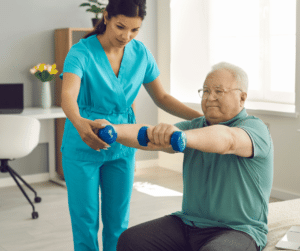Home Health Rehab – What Older Adults Can Expect

Home Health Rehab has become a valuable and essential mode of providing rehabilitation services to people of all ages and medical necessities. As defined by the American Physical Therapy Association, “Home health care is provision of skilled therapy services in the patient’s place of residence.
Home care may actually be provided in the patient’s residence, the caregiver’s home, a hospital emergency room, skilled nursing facility, residential facility, group home, hospice, or elsewhere in the community.” [1]
Types of Home Health Rehab
There are two different types of Home Health Rehab services for seniors.
1) Services that one may need after undergoing care at a hospital or after a significant acute incident
2) Services that one may need on an outpatient basis due to either a recent incident or aggravation of a prior injury/illness
 Under the first type, when someone is discharging to their place of residence after undergoing a stay at the hospital, they usually get offered or referred home health services.
Under the first type, when someone is discharging to their place of residence after undergoing a stay at the hospital, they usually get offered or referred home health services.
These services directly result from the acute illness for which one had to seek medical care at the hospital. This may entail a combination of different clinicians. For example, it could include a nurse, physical therapist, occupational therapist, speech therapist, home health aide, or others.
Under the second type, clients usually only need a therapist and may not need other clinicians. This occurs primarily when someone notices a change in their lifestyle or abilities as a result of an incident. The incident could be a minor fall without any serious injuries, a decline in muscle strength due to lack of optimal exercise, or a decline in balance due to the aging process, etc. type of physical issue.
Understanding Differences in Home Health Rehab Services
Let’s look at a hypothetical example that can help us better understand the difference between the two types of home health rehab services.
Meet Mrs. Smith
Mrs. Smith undergoes a total knee replacement surgery due to suffering from severe arthritis. When she returns back home, she is expected to have some difficulties in performing her day-to-day activities as a result of pain and impairment with her knee movement.
So, she gets referred to Home Health Services. Her service includes a nurse and a physical therapist as a follow-through of the hospital services. The goal is to help her recover from pain and impairment with moving her knee in the full range required to perform routine movement and walking activities.
In-Home Rehab Option After Surgery
Since she has just returned from the hospital and is in a lot of pain and discomfort, she is unable to take herself to a physical therapy clinic. Hence, she qualifies for home health services for the acute illness, which, in this case, is the total knee replacement surgery.
The assigned nurse would assess and monitor the care of the incision on the knee to make sure it is healing like it should and there are no signs of infection etc. The nurse would also ascertain that Mrs. Smith has all her medications set up appropriately and would get her additional necessities or resources that she may need to successfully recover from her surgery.
Her physical therapist would focus primarily on the movement and strength-related issues to make sure Mrs. Smith can safely perform all her activities and daily routine as close to or better than what she had been doing prior to the surgery. The physical therapist would work on strengthening her leg and knee muscles while teaching her strategies to minimize pain and discomfort during mobility activities. In addition, the therapist would discharge Mrs. Smith once she meets her goals of being able to perform her activities at a certain level of independence.
More About In-Home Rehab
Now, let’s assume Mrs. Smith completely recovers from her knee replacement issues and six months later, she notices that she has been having close calls with losing her balance while walking or while doing her daily routine activities. She has not had any other medical issues since she came home and graduated from her knee rehab. However, she feels her balance is getting worse and that’s why she is feeling unsteady.
unsteady.
She may qualify to be evaluated for outpatient rehab services. This is because there is no acute illness associated with the change in her physical functioning that would warrant getting a nurse or other additional personnel involved in care planning. And she is likely to just need a physical therapist.
She can choose to consult with her primary care physician who may give her a script for physical therapy. Then she can avail of the rehab services either by going to an outpatient clinic OR by having a therapist come to her place of residence.
She may prefer to have someone come to her home if she does not feel safe driving to the clinic due to her balance problems and feels it may be better to have the therapist see her at her residence.
Benefits of In-Home Rehab Services
There are many possible benefits of in-home outpatient-type rehab services:
- Reduces the need to travel to a clinic and allows seniors to schedule services they need at a time convenient to them, in their place of residence thereby minimizing risk of falls and other challenges.
- Reduces chances of further injuries while trying to get to a clinic in inclement weather or hazardous driving conditions.
- Decreases reliance on caregivers/friends/family members for having to drive their loved ones to a location if the client themself is
 unable to drive for any reason.
unable to drive for any reason. - Therapists can assess the client in their own surroundings thus having a realistic idea of what issues the client faces on a day-to-day basis and how to remedy them.
- They are covered by Medicare Part B plans and may be covered by private insurance Medicare replacement or Medicare Advantage plans or non-Medicare plans.
From the Author
Hope you enjoyed reading this article on Home Health Rehab services. In the next article, we will explore the topic of “Rehabilitative Therapy – questions to ask your Physical Therapist!”
I look forward to having an engaging conversation with you. Please feel free to reach me at dbhatt@namasterehab.com if you have any questions/suggestions regarding this article or topic.
Contributed by: Darshan Bhatt, DPT
 Darshan Bhatt is a physical therapist by training. He has worked in various healthcare settings around the country. He is the Founder and currently serves as President of Namaste Rehab. Namaste Rehab is a company that provides therapy services to seniors at their place of residence. Namaste Rehab’s motto is, “Why go to the clinic if the clinic can come to you!”
Darshan Bhatt is a physical therapist by training. He has worked in various healthcare settings around the country. He is the Founder and currently serves as President of Namaste Rehab. Namaste Rehab is a company that provides therapy services to seniors at their place of residence. Namaste Rehab’s motto is, “Why go to the clinic if the clinic can come to you!”
Darshan was born and raised in India. He moved to the United States for Graduate Schooling. He got his Master’s Degree from University of Buffalo. And then got his Doctor of Physical Therapy Degree from Utica University. He has lived and worked in the Greater Philadelphia area for the past 12+ years.
After seeing the dire need for rehab services for seniors who could not access care during the COVID pandemic, Darshan decided to start his company. He decided to cater to clients who could not access care or would rather choose to receive services at home for convenience, safety or other reasons.
Darshan lives in Montgomery County with his wife and 2 kids. He enjoys traveling, kayaking, camping and spending time with his kids during his free time. He has a passion for senior rehab services. And he takes every chance he gets to host seminars and educational lectures for senior healthcare awareness.
Sources: (1) American Physical Therapy Association, “Bringing Physical Therapy Home,” www.homehealthsection.org, 21 1 2024 accessed.
Friends Life Care posts on the eMeetinghouse blog. This is another way to share wellness information with older adults. Friends Life Care is a Quaker value-based nonprofit. The organization has a mission to help older adults age well. For questions about Friends Life Care, contact a F\Plan Counselor.
If you are already a member, reach out directly to your dedicated care coordinator.
Leave a Comment
